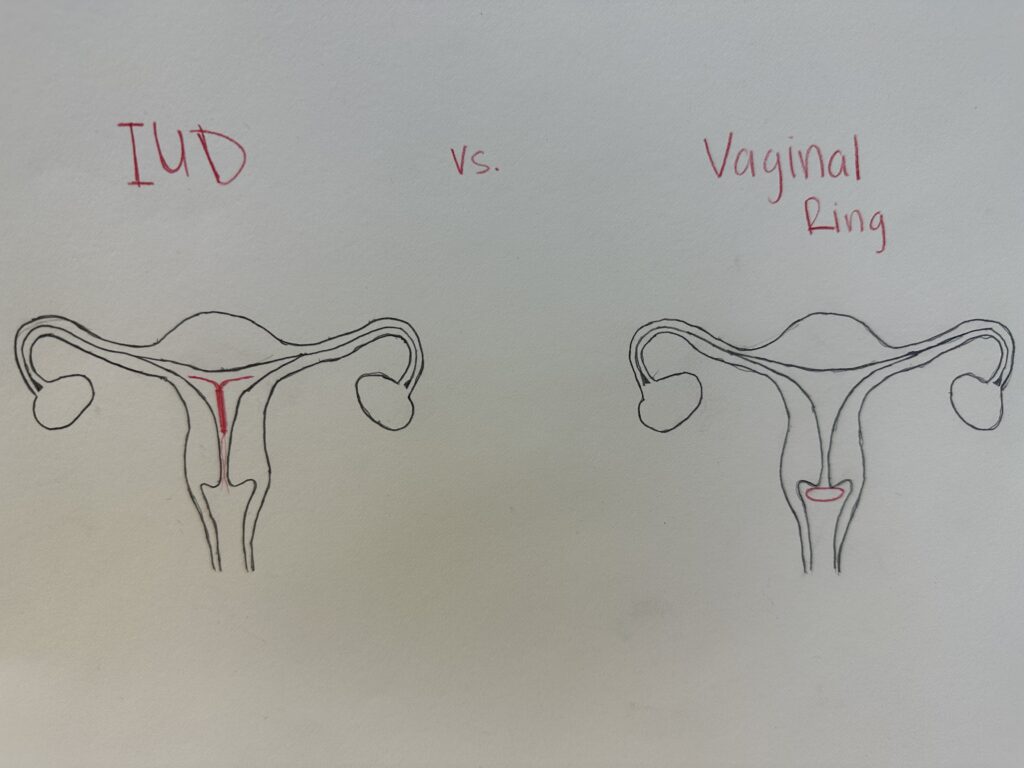
My STEAM project is about the differences between two types of birth control, the vaginal ring and the hormonal IUD. It falls under the objective describing how ovulation, menses, pregnancy, and spermatogenesis are hormonally regulated. I am going to be talking about how both types of birth control regulate the menstrual cycle, affect the body, and their differences and similarities.
There are several types of vaginal ring birth controls. They are very similar in size, schedule, and hormones. They all sit in the vaginal canal up against the opening of the cervix. They are left in the body for three weeks and are taken out for one week, the “period”. The ring releases estrogen and progesterone to trick your body into thinking it’s pregnant. The hormones enter the bloodstream through the walls of the vagina. The estrogen and progesterone trick the body into not ovulating. The ring is similar to birth control pills in that way. It also thickens the fluid around the opening of the cervix to help prevent any sperm from getting in. Vaginal rings have a 98%-99% effective rate if used correctly. Human error, such as taking the ring out for an extended period of time or leaving it in for over 3 weeks, can decrease its effectiveness. Vaginal rings are an attractive form of birth control because of the high efficacy, less hormones, and the comfort and ease of insertion and removal. The ring can have negative side effects like nausea, irregular bleeding, and increased vaginal discharge. If the ring’s side effects are extreme a different birth control may be best.
IUD stands for intrauterine device. It is a device that is inserted into the uterus via the cervical opening. There are two types of IUDs, hormonal and nonhormonal. I will be talking about hormonal IUDs. There are many different types of hormonal IUD. Each differs in size, hormones, and longevity. The most common hormone in IUDs is progesterone. The IUD works by releasing progesterone into the cervix to thicken the cervical mucus making it more difficult for the sperm to reach the egg. The IUD itself is also a foreign body in the uterus that sperm do not like. The IUD is 99% effective. There are also advantages to an IUD. Some advantages are that it may be used during breastfeeding, it usually doesn’t affect mood or sex drive, and lasts for years. Some negative side effects are pain during insertion, it cannot be inserted into all women, and it may spontaneously dislodge. The IUD makes the uterus an inhospitable environment for attachment. To get an IUD you have to have an in-office procedure. There the doctor will use tools to insert the IUD into the uterus through the cervical opening. Longevity of hormonal IUDs range from 3-7 years. After your IUD expires you can return to the doctor. and have it removed. You then can have another one inserted or switch forms of birth control.
All forms of birth control are slightly different but they all regulate the menstrual cycle to prevent pregnancy. If one form of birth control doesn’t fit with one body there are many other options to try.
Barranquero Gómez, M. (2019, December 16). Vaginal Ring As Mean Of Contraception: How Does It Work? InviTRA. https://www.invitra.com/en/vaginal-ring/
Better Health Channel. (2012). Contraception – vaginal ring. Vic.gov.au. https://www.betterhealth.vic.gov.au/health/healthyliving/contraception-vaginal-ring
Brown Health Services. (2017). Intrauterine Device (IUD) Brown Health Services Patient Education Series. https://healthservices.brown.edu/sites/default/files/IUD%2017.pdf
Centers for Disease Control and Prevention. (2019). Contraception. Centers for Disease Control and Prevention. https://www.cdc.gov/reproductivehealth/contraception/index.htm
Rodrigo, A., Sosa, D., & Barranquero Gómez, M. (2019, October 31). How Does the IUD Work and What are the Pros & Cons ? InviTRA. https://www.invitra.com/en/iud-intrauterine-device/

McCall Parkinsons steam project is on the difference between using a vaginal ring verses a IUD for birth control. Both are effective ways to prevent pregnancy with a vaginal ring having a 98% to 99% and the IUD having a 99% effectiveness rate. Vaginal rings sit in the vaginal canal next to the opening of the cervix and release hormones estrogen and progesterone to trick the body into thinking it is pregnant. It also thickens the mucus in the cervix which plugs it and prevents sperm from getting in. The ring sits there for three weeks then is taken out for one week for the period. It can have some side effects. The hormonal IUD works by releasing progesterone. This thickens the mucus in the walls of the uterus which makes it hard for the sperm to reach the egg. It is also a foreign body in the uterus which the sperm don’t appreciate. The IUD’s side effects happen during insertion by the doctor or removal.